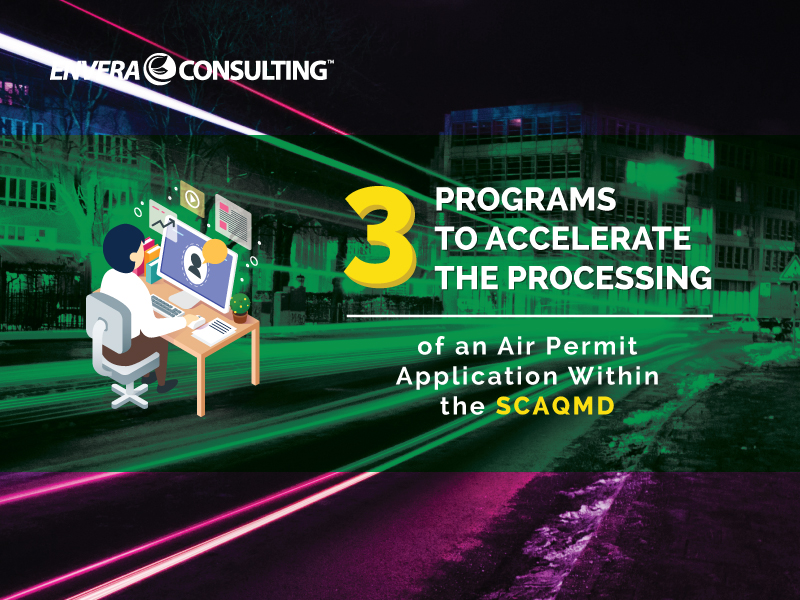

Air-permit applications often pose a high hurdle for manufacturing facilities that want to purchase equipment for business expansion, particularly when it comes to how long the SCAQMD process takes.
Yes, the process can often take longer than waiting for the next season of Game of Thrones. But fear not! There are two bright points:
- You can take steps to expedite the process.
- The agency has streamlining programs in place.
In this article, I’ll touch upon the second part.
You can read through the Permit Streamline Guidance Document prepared by the California Air Pollution Control Officers’ Association and the California Air Resources Board (CARB) to find out about the ongoing and planned programs designed to expedite the permitting process.
In fact, some of the largest air districts in California (i.e., those with a population greater than 250,000) are required (by Assembly Bill 2781, if you’re curious) to adopt systems for expedited permit processing. The SCAQMD even has a task force that is focused on exploring and developing various processing efficiencies.
Of all the permit streamlining programs, three of the most common are the:
- Certified Permitting Professional program (CPP)
- Expedited Permit Processing program (XPP)
- Certified Equipment program (CEP)
Each one of these can greatly help expedite the processing of your permit application, but these programs don’t work on their own. As the applicant, you need to make sure that you prepare a complete permit application — one that contains all of the information needed for the SCAQMD to actually process the application.
Certified Permitting Professional Program (CPP)
The SCAQMD CPP program certifies private consultants to prepare correct and complete permit applications. One of the biggest time sucks in the application process is the back-and-forth between the applicant and the engineer simply because an application was not completed properly. The CPP program attempts to solve this problem.
When the application has been submitted by a Certified Permitting Professional, the engineer has some assurance that the permit application is complete and, therefore, can be processed without too much problem or delay.
To take advantage of the program, simply contact one of the consultants on the list. (We’re on there, so you can also just contact us.)
Expedited Permitting Processing Program (XPP)
The XPP allows applicants to pay a fee (currently 50 percent of the base fee of the equipment being permitted) for the privilege of having your permit expedited. The XPP fee is submitted to the SCAQMD at the same time as your air-permit application. By submitting the fee, you’re actually authorizing the permit engineer to work overtime so they can process your application more quickly.
Note that expediting is dependent on the availability of SCAQMD staff. In some cases, the SCAQMD may not even have the staff available to process your application in an expedited manner. If that happens, your XPP fees will be refunded.
It’s also important to note that just because you’re paying this extra fee doesn’t mean that you don’t have to submit a proper application. Even if an engineer works overtime, they can’t complete the process if you’re missing parts of your application or haven’t provided the appropriate information. So you’ll just be going back-and-forth again, only this time, you’re paying for that privilege.
We always recommend speaking with your permit engineer — prior to the submission of your application — to get an idea of what information is needed to process the application and if expedited permit process is an option.
Certified Equipment Program (CEP)
As part of this program, the SCAQMD pre-certifies mass-produced equipment that operates under the same or similar conditions. The SCAQMD website shows the following as examples of such equipment, including:
- Certified residential-type, natural gas-fired water heaters
- Certified large water heaters and small boilers and process heaters
- Certified ICE emergency generators list
- Automotive spray booth make-up air units
- Certified charbroilers with integrated catalyst
- Certified street sweepers
Out of all of these certified equipment types, by far the most common are emergency generators. So if you’re in the market for one, I highly recommend buying one that’s certified.
However, not all facility types are able to make use of the certified engine program. Your facility is ineligible to participate in the program if:
- The engine or facility is Title V
- The engine is within 1,000 feet of a school
If you’re one of the lucky facilities that can use the certified engine program, the permitting process can be lickety-split (compared to the full process, that is).